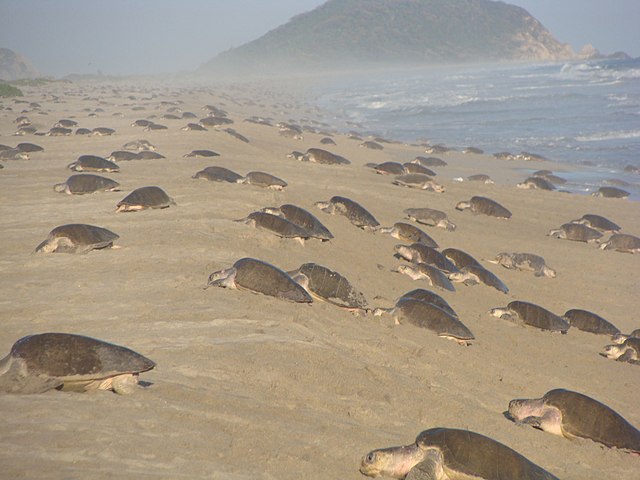 Eder Omar Campos González,
Eder Omar Campos González,
Today is World Turtle Day again, and for me that brings to mind how, in a world chock full of amazing natural phenomena, few if any that I have witnessed have moved me more than the bond that giant marine turtles have with the beaches where they were born. Every year, female sea turtles make their way hundreds, sometimes thousands of miles back to lay their eggs on these same beaches, and that time of year has arrived up and down Central America – varying a bit from place to place, but roughly peaking in most areas from July through January.
At various points along the coasts (both Pacific and Caribbean, depending on the country) of Costa Rica, El Salvador, Nicaragua, and Panama, and in various cycles between now and January, thousands upon thousands of mama turtles (hawksbill, leatherback, and olive ridleys) swarm ashore en masse – a phenomenon called the arribada, and drag themselves dozens of feet onto the beach before vigorously digging holes with their flippers and depositing dozens, sometimes hundreds of leathery eggs.
Several years ago I had the privilege of witnessing this extraordinary sight on a moonlit strand at Gandoca, on Costa Rica’s Caribbean coast. And more recently, on the Pacific coast, this time in El Salvador, I also got to see the flip side of that as I joined a group of conservationist volunteers helping tiny turtle hatchlings race back into the surf.
In nature, a certain number of these little guys don’t make that ragged race from egg to ocean, thanks to swooping sea birds and such. But in recent years conservationists have been slowly been making inroads into the even greater challenge these endangered turtles have faced: humans from surrounding communities with less-than-stellar economic prospects who poached eggs and slaughtered adults for meat and shells. The aim is to demonstrate to the locals that preserving the turtles can generate tourism, which will benefit them much more than a few stolen eggs and turtle carcasses.
Following are nine of the top spots where programs are set up for visitors to witness or even help in these efforts during the sea turtle nesting and hatching seasons:
Costa Rica
Playa Gandoca South of the Caribbean coast’s main resort center, Puerto Viejo, and the smaller village of Manzanillo, the beach in the Gandoca-Manzanillo Refuge is where the hard-shelled mamas congregate. Nesting here is March through June and hatching in July and August. Arrange activities through local eco provider ATEC.
Playa Ostional On the Nicoya Pensinsula near Nosara, this Pacific beach is part of a wildlife refuge and famous for its olive ridleys, with access coordinated by the local development association ADIO. More information.
Tortuguero National Park Like Gandoca on the Caribbean side, but farther north, the name of this mini-Amazon itself means “place of turtles”, thanks to its outer stretch of wild beach, a magnet for sea turtles of various types (this species also comes in to lay eggs March through May as well as July-October). There are eco lodges here as well as various turtle tour options. More information.
El Salvador
Several beaches along the Pacific Coast get arribadas at varying points between May and December, including Playa San Blas (which is where I had the pleasure), Playa San Diego, and Playa Los Cóbanos; the country is small enough that they’re all a fairly easy drive from the capital San Salvador, or there are hotels and resorts out here to overnight. More information.
Guatemala
Here the action happens a roughly three-hour drive from capital Guatemala City ((as well as lovely colonial Antigua) in the Pacific coast beach town of Monterrico, its fetching black-sand beaches (above) and kicky waves popular with surfers and swimmers but also known for its beachfront Tortugario Monterrico, a 41-year-old, university-run facility devoted to the nurturing and protection of endangered olive ridley, leatherback, and green sea turtles., as well as alligators, crocodiles, and iguanas.
Nicaragua
Playa La Flor, San Juan del Sur Seven major arribadas during the season at this beach, part of a reserve on the Pacific Coast, with carefully regulated tours offered by tour operators out of the surfer-oriented town of San Juan del Sur, 14 miles (22 kilometers) north, such as Servi-Tours Travel Tips.
Panama
Bluff Beach, Bocas del Toro This paradisiacal Caribbean-side community is a great place to spot hawksbills and leatherbacks, via local organizations ANABOCA or Bocas Carey Eco Tour.
Playa Soropta, Bocas del Toro The Sea Turtle Conservancy has a leatherback protection and restoration program here for which it accepts volunteers.
Wherever you do it, this is one eco-experience to put firmly on your bucket list!
Comments